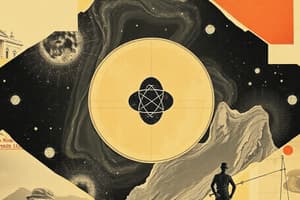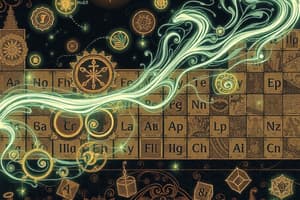Podcast
Questions and Answers
What is the charge of group 1 element?
What is the charge of group 1 element?
- 0
- +2
- +3
- +1 (correct)
What is the charge of group 2 element?
What is the charge of group 2 element?
- +1
- -1
- +3
- +2 (correct)
What is the charge of group 3 element?
What is the charge of group 3 element?
- +3 (correct)
- +2
- +1
- -3
What is the charge of group 4 element?
What is the charge of group 4 element?
What is the charge of group 5 element?
What is the charge of group 5 element?
What is the charge of group 6 element?
What is the charge of group 6 element?
What is the charge of group 7 element?
What is the charge of group 7 element?
What is the charge of group 8 element?
What is the charge of group 8 element?
What is the symbol for a zinc ion?
What is the symbol for a zinc ion?
What is the symbol for a silver ion?
What is the symbol for a silver ion?
What is the symbol for a hydrogen ion?
What is the symbol for a hydrogen ion?
What is the symbol for ammonium ion?
What is the symbol for ammonium ion?
What is the symbol for a nitrate ion?
What is the symbol for a nitrate ion?
What is the symbol for a hydroxide ion?
What is the symbol for a hydroxide ion?
What is the symbol for a carbonate ion?
What is the symbol for a carbonate ion?
What is the symbol for a sulphate ion?
What is the symbol for a sulphate ion?
What charge must all ionic formulas add up to?
What charge must all ionic formulas add up to?
What is the chemical formula for hydrochloric acid?
What is the chemical formula for hydrochloric acid?
What is the chemical formula for nitric acid?
What is the chemical formula for nitric acid?
What is the chemical formula for sulfuric acid?
What is the chemical formula for sulfuric acid?
What is the chemical formula for phosphoric acid?
What is the chemical formula for phosphoric acid?
What is the chemical formula for magnesium chloride?
What is the chemical formula for magnesium chloride?
What is the chemical formula for calcium sulfide?
What is the chemical formula for calcium sulfide?
What is the chemical formula for aluminium nitrate?
What is the chemical formula for aluminium nitrate?
What is the chemical formula for ammonium sulfate?
What is the chemical formula for ammonium sulfate?
What is the symbol for a gas?
What is the symbol for a gas?
What is the symbol for a solid?
What is the symbol for a solid?
What is the symbol for a liquid?
What is the symbol for a liquid?
What is the symbol for aqueous solution?
What is the symbol for aqueous solution?
Which substance gives a squeaky pop with a lit splint?
Which substance gives a squeaky pop with a lit splint?
What substance relights a glowing splint?
What substance relights a glowing splint?
What substance turns blue cobalt chloride paper pink?
What substance turns blue cobalt chloride paper pink?
What substance turns orange bromine water colorless?
What substance turns orange bromine water colorless?
What substance boils at exactly 100 degrees and freezes at 0?
What substance boils at exactly 100 degrees and freezes at 0?
How do you test for carbon dioxide?
How do you test for carbon dioxide?
What is the observation for the carbon dioxide limewater test?
What is the observation for the carbon dioxide limewater test?
What are two methods for testing for water?
What are two methods for testing for water?
What is the observation for the cobalt chloride paper test?
What is the observation for the cobalt chloride paper test?
What is the observation for the anhydrous copper sulfate test?
What is the observation for the anhydrous copper sulfate test?
What are the products of a complete combustion of a hydrocarbon?
What are the products of a complete combustion of a hydrocarbon?
What are the products of incomplete combustion of a hydrocarbon (gas products)?
What are the products of incomplete combustion of a hydrocarbon (gas products)?
What are the products of incomplete combustion of a hydrocarbon (solid products)?
What are the products of incomplete combustion of a hydrocarbon (solid products)?
What is the mass of a proton?
What is the mass of a proton?
What is the mass of a neutron?
What is the mass of a neutron?
What is the mass of an electron?
What is the mass of an electron?
What is the charge of a proton?
What is the charge of a proton?
What is the charge of a neutron?
What is the charge of a neutron?
What is the charge of an electron?
What is the charge of an electron?
Where is the proton located?
Where is the proton located?
Where is the neutron located?
Where is the neutron located?
Where is the electron located?
Where is the electron located?
What substance turns anhydrous copper sulfate from white to blue?
What substance turns anhydrous copper sulfate from white to blue?
What is the most abundant gas in the atmosphere?
What is the most abundant gas in the atmosphere?
What is the percentage of nitrogen in the air?
What is the percentage of nitrogen in the air?
What is the percentage of carbon dioxide in air?
What is the percentage of carbon dioxide in air?
What is the percentage of argon in air?
What is the percentage of argon in air?
What is the percentage of oxygen in air?
What is the percentage of oxygen in air?
What method is used to separate gases in the air?
What method is used to separate gases in the air?
Flashcards
Group 1 Element Charge
Group 1 Element Charge
Elements in Group 1 of the periodic table have a +1 charge.
Group 2 Element Charge
Group 2 Element Charge
Elements in Group 2 have a +2 charge.
Group 5 Element Charge
Group 5 Element Charge
Elements in Group 5 have a -3 charge.
Group 6 Element Charge
Group 6 Element Charge
Signup and view all the flashcards
Group 7 Element Charge
Group 7 Element Charge
Signup and view all the flashcards
Zn²⁺
Zn²⁺
Signup and view all the flashcards
Ag⁺
Ag⁺
Signup and view all the flashcards
OH⁻
OH⁻
Signup and view all the flashcards
CO₃²⁻
CO₃²⁻
Signup and view all the flashcards
Ionic Charge Balance
Ionic Charge Balance
Signup and view all the flashcards
HCl
HCl
Signup and view all the flashcards
HNO₃
HNO₃
Signup and view all the flashcards
MgCl₂
MgCl₂
Signup and view all the flashcards
(g)
(g)
Signup and view all the flashcards
(s)
(s)
Signup and view all the flashcards
(l)
(l)
Signup and view all the flashcards
(aq)
(aq)
Signup and view all the flashcards
Hydrogen Test
Hydrogen Test
Signup and view all the flashcards
Oxygen Test
Oxygen Test
Signup and view all the flashcards
Alkene Test
Alkene Test
Signup and view all the flashcards
Carbon Dioxide Test
Carbon Dioxide Test
Signup and view all the flashcards
Cobalt chloride paper with water
Cobalt chloride paper with water
Signup and view all the flashcards
Complete Combustion Products
Complete Combustion Products
Signup and view all the flashcards
Incomplete Combustion Products
Incomplete Combustion Products
Signup and view all the flashcards
Proton Charge
Proton Charge
Signup and view all the flashcards
Neutron Charge
Neutron Charge
Signup and view all the flashcards
Electron Charge
Electron Charge
Signup and view all the flashcards
Nucleus Contents
Nucleus Contents
Signup and view all the flashcards
Electron Location
Electron Location
Signup and view all the flashcards
Atmospheric Nitrogen
Atmospheric Nitrogen
Signup and view all the flashcards
Study Notes
Basic Charges of Elements
- Group 1 elements have a charge of +1.
- Group 2 elements have a charge of +2.
- Group 3 elements have a charge of +3.
- Group 4 elements can have a charge of +4 or -4.
- Group 5 elements have a charge of -3.
- Group 6 elements have a charge of -2.
- Group 7 elements have a charge of -1.
- Group 8 elements have a neutral charge (0).
Ion Symbols
- Zn²⁺ represents a zinc ion.
- Ag⁺ represents a silver ion.
- H⁺ denotes a hydrogen ion.
- NH₄⁺ signifies an ammonium ion.
- NO₃⁻ indicates a nitrate ion.
- OH⁻ denotes a hydroxide ion.
- CO₃²⁻ indicates a carbonate ion.
- SO₄²⁻ represents a sulfate ion.
Ionic Charge Balance
- The total charge in ionic formulas must equal zero.
Chemical Formulas of Acids and Compounds
- HCl is hydrochloric acid.
- HNO₃ represents nitric acid.
- H₂SO₄ is sulfuric acid.
- H₃PO₄ signifies phosphoric acid.
- MgCl₂ indicates magnesium chloride.
- CaS represents calcium sulfide.
- Al(NO₃)₃ is aluminum nitrate.
- (NH₄)₂SO₄ signifies ammonium sulfate.
Physical States Symbols
- (g) indicates gas.
- (s) denotes solid.
- (l) represents liquid.
- (aq) signifies aqueous solution.
Chemical Tests and Observations
- Hydrogen produces a squeaky pop with a lit splint.
- Oxygen relights a glowing splint.
- Water turns blue cobalt chloride paper pink.
- Alkenes decolorize orange bromine water.
- Water boils at 100°C and freezes at 0°C.
- Carbon dioxide can be tested using limewater.
- The limewater test yields a cloudy observation for carbon dioxide.
- Cobalt chloride paper turns from blue to pink when it contacts water.
- Anhydrous copper sulfate changes from white to blue when it comes into contact with water.
Combustion Products
- Complete combustion of hydrocarbons produces carbon dioxide and water.
- Incomplete combustion can produce carbon monoxide and water (gas products).
- Incomplete combustion may also yield carbon and water (solid products).
Atomic Mass and Charge
- A proton has a mass of approximately 1 atomic mass unit (amu).
- A neutron also has a mass of approximately 1 amu.
- An electron has a mass of 1/2000 amu.
- Protons carry a charge of +1.
- Neutrons have no charge (0).
- Electrons carry a charge of -1.
Atomic Structure
- Protons and neutrons are located in the nucleus of an atom.
- Electrons are located in shells surrounding the nucleus.
Atmospheric Composition
- Nitrogen is the most abundant gas in the atmosphere, comprising 78%.
- Carbon dioxide constitutes 0.04% of the atmosphere.
- Argon represents 0.9% of atmospheric gases.
- Oxygen makes up 21% of the atmospheric composition.
Separation of Gases
- Fractional distillation is the method employed to separate gases in the air.
Studying That Suits You
Use AI to generate personalized quizzes and flashcards to suit your learning preferences.




